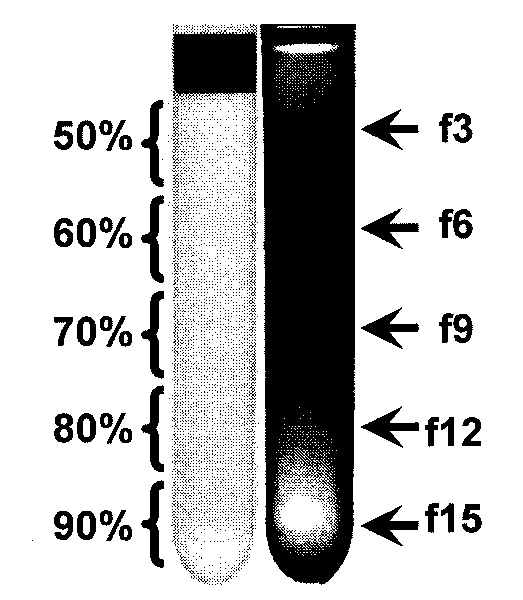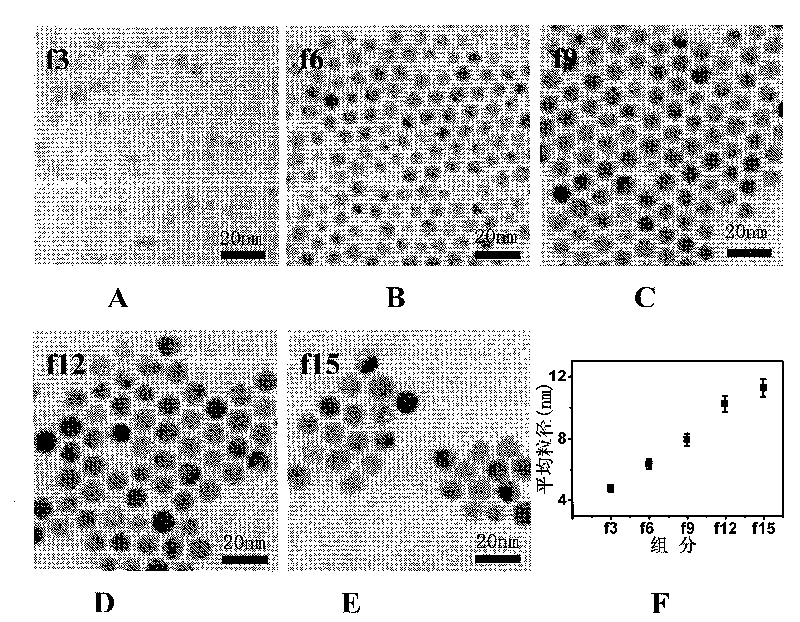Method for centrifugally separating oil soluble nano particles by organic density gradient
A nanoparticle and density gradient technology is applied in the field of advanced nanomaterial separation technology to achieve a wide range of separation sizes, simple purification and good separation effect.
- Summary
- Abstract
- Description
- Claims
- Application Information
AI Technical Summary
Problems solved by technology
Method used
Image
Examples
Embodiment 1
[0025] (1) First, use 10mg / ml of HAuCl 4 The oleylamine solution was reacted with 10ml cyclohexane at 80°C for 10h to generate a cyclohexane colloidal solution of about 1mg / ml Au nanoparticles.
[0026] (2) Make a density gradient: use carbon tetrachloride and cyclohexane to prepare 50%, 60%, 70%, 80%, and 90% carbon tetrachloride-cyclohexane solutions by volume. Starting from 90%, gradually take 2ml of the solution and gently add it to the centrifuge tube to prepare a gradient solution.
[0027] (3) Add 0.4 ml cyclohexane dispersion of Au nanoparticles to the gradient liquid.
[0028] (4) 15°C, 100×10 -6 Atmospheric pressure, 25000rpm, high-speed centrifugation under the condition of 10min.
[0029] (5) Divide the centrifuged mixture into 16 parts, and suck it out from the top with a pipette. Finally, Au nanoparticle dispersions with different sizes were obtained.
[0030] For separation results, see figure 1 ,2.
[0031] Change the separation conditions, change the de...
Embodiment 2
[0033] (1) First, use 10mg / ml of HAuCl 4 5ml of oleylamine solution was reacted with 5ml of cyclohexane at 50°C for 72h to generate a colloidal solution of about 5mg / ml Au nanowires / nanoparticles.
[0034] (2) Preparation of density gradient: use carbon tetrachloride and cyclohexane to prepare 50%, 60%, 70%, 80%, 90% carbon tetrachloride-cyclohexane solutions by volume. Starting from 90%, gradually take 2ml of the solution and gently add it to the centrifuge tube to prepare a gradient solution.
[0035] (3) Add 0.4 ml of the synthesized Au nanowire / nanoparticle colloidal solution to the gradient solution.
[0036] (4) 15°C, 100×10 -6 Atmospheric pressure, 30000rpm, high-speed centrifugation under the condition of 18min.
[0037] (5) Divide the centrifuged mixture into 26 parts, and suck it out from the top with a pipette. Finally, nanoparticle dispersions with different sizes and shapes are obtained.
[0038] For separation results, see image 3
[0039] Change the sepa...
Embodiment 3
[0041] (1) First, take 2ml of Fe wrapped in oleic acid 3 o 4 The cyclohexane colloidal solution of nanoparticles was ultrasonicated for 4 hours, and the water was changed every half hour.
[0042] (2) Make a density gradient: use carbon tetrachloride and cyclohexane to prepare 50%, 60%, 70%, 80%, and 90% carbon tetrachloride-cyclohexane solutions by volume. Starting from 90%, gradually take 2ml of the solution and gently add it to the centrifuge tube to prepare a gradient solution.
[0043] (3) Add 0.4ml of Fe 3 o 4 A colloidal solution of nanoparticles is added to the gradient.
[0044] (4) 15°C, 100×10 -6 Atmospheric pressure, 35000rpm, high-speed centrifugation under the condition of 35min.
[0045] (5) Divide the centrifuged mixture into 20 parts, and suck it out from the top with a pipette. Finally, Fe with different sizes is obtained 3 o 4 nanoparticle dispersion.
[0046] For separation results, see Figure 4
[0047] Change the separation conditions, change...
PUM
 Login to View More
Login to View More Abstract
Description
Claims
Application Information
 Login to View More
Login to View More - R&D Engineer
- R&D Manager
- IP Professional
- Industry Leading Data Capabilities
- Powerful AI technology
- Patent DNA Extraction
Browse by: Latest US Patents, China's latest patents, Technical Efficacy Thesaurus, Application Domain, Technology Topic, Popular Technical Reports.
© 2024 PatSnap. All rights reserved.Legal|Privacy policy|Modern Slavery Act Transparency Statement|Sitemap|About US| Contact US: help@patsnap.com










